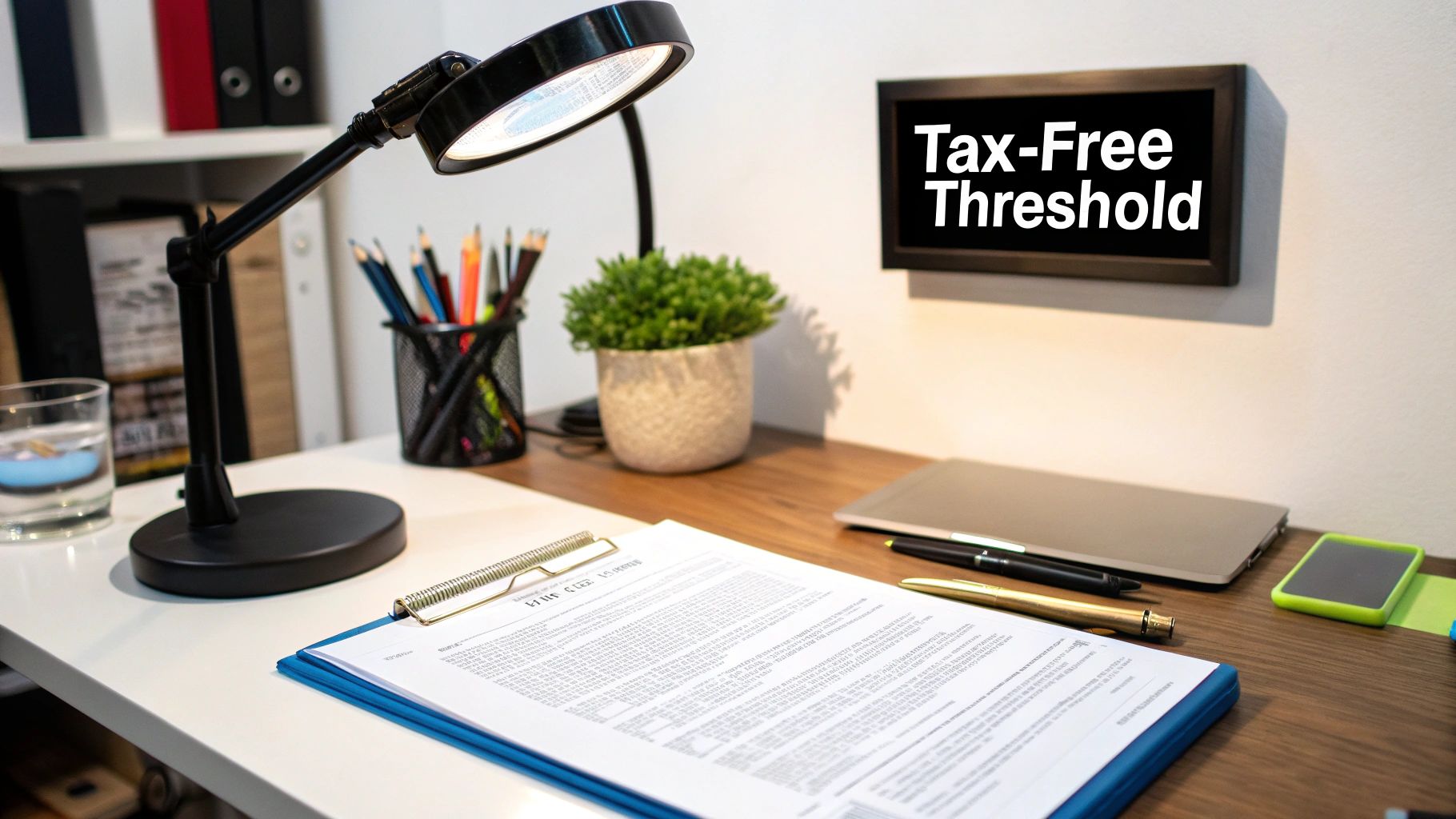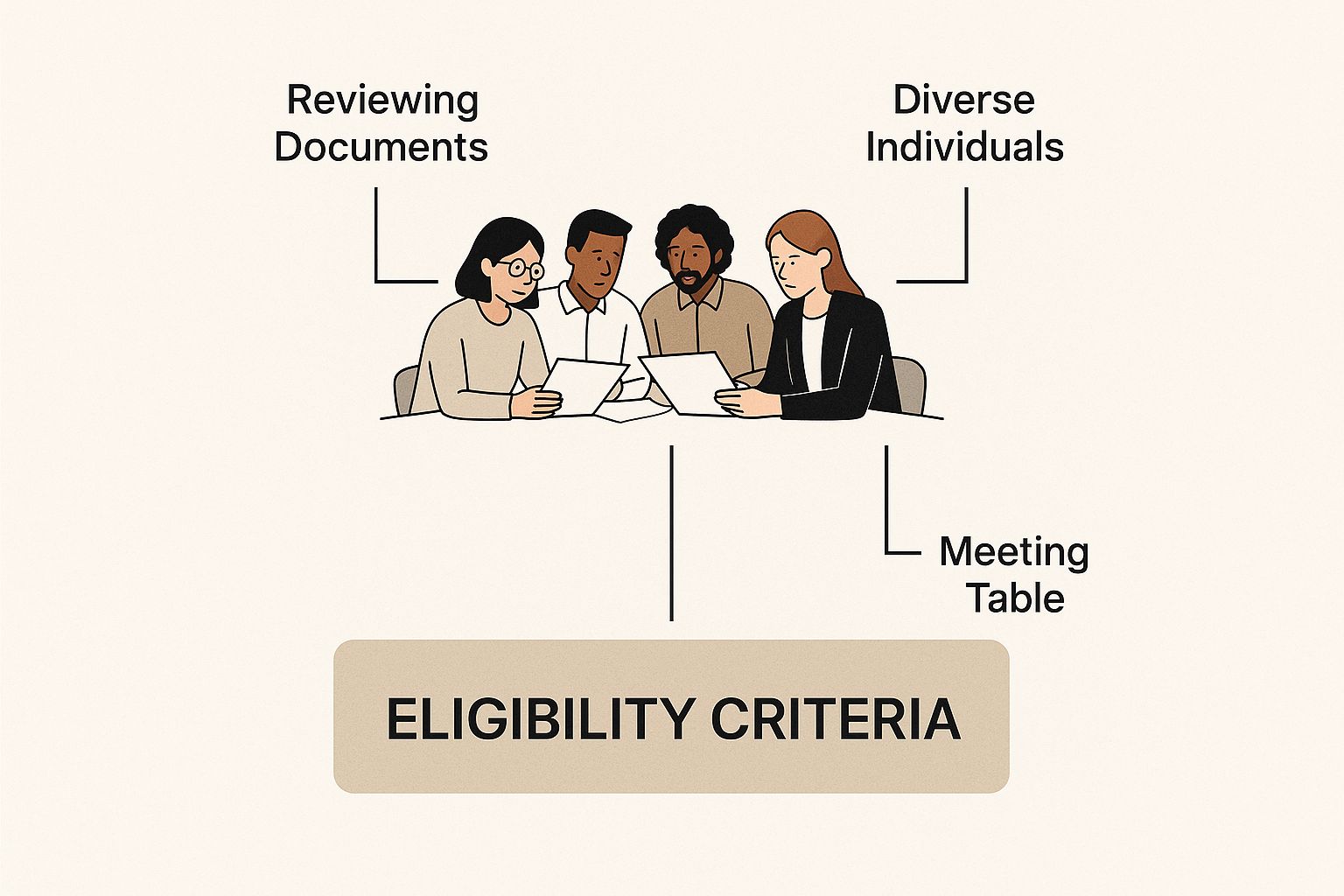When you start earning money in Australia, you don't start paying tax on the very first dollar. That's thanks to something called the tax-free threshold. For most Australian residents for tax purposes, this means the first $18,200 earned in a financial year is not subject to income tax. It's a fundamental feature of the Australian tax system.
Decoding the Tax-Free Threshold

The threshold is essentially the amount of income you can earn—$18,200—before you are required to pay income tax. This system is a core feature of Australian tax law, designed to ease the burden on lower-income earners and ensure everyone keeps a portion of what they make.
The $18,200 figure isn't set in stone forever; it can be adjusted over time. Its main function is to ensure a portion of an average worker's pay is not taxed, which has been a cornerstone of our tax system for a long time.
While it's a basic concept, understanding what it is and how it functions are two different things. Understanding the threshold is the first real step to confidently managing your tax affairs.
For a quick summary, here’s the tax-free threshold at a glance:
| Tax-Free Threshold at a Glance | |
|---|---|
| Attribute | Details |
| Current Amount | $18,200 per financial year |
| Who Can Claim It? | Most Australian residents for tax purposes |
| Primary Rule | Can only be claimed from one employer at a time |
| Purpose | To reduce the tax burden on low to middle-income earners |
This table neatly sums up the essentials, but the details of how it applies can vary based on an individual's specific situation.
Who It Applies To
So, who is eligible for this tax-free amount? Generally, it applies to anyone who is considered an Australian resident for tax purposes. This is a very important point—it’s not about your citizenship or visa status but about your specific circumstances as defined by the tax office.
Here are the key things to understand:
- One Job at a Time: A person should only claim the tax-free threshold from one employer. If you have a second job, you'll need to tell that employer not to claim it for PAYG withholding purposes. Otherwise, you'll likely have a tax liability at the end of the year.
- Residency is Key: Eligibility hinges on being a tax resident.
- Helps Everyone (But Mostly Lower Earners): While it applies to all income levels, the benefit is most felt by those on lower to middle incomes, as it represents a larger percentage of their total earnings.
Trying to figure out your tax obligations can feel like a maze. But once you break down these core ideas, it all becomes much clearer. For more practical information, have a look through our other resources on tax and compliance.
Disclaimer: This article provides general information and does not constitute financial or tax advice. Please consult a professional advisor for guidance specific to your situation.
How the Tax-Free Threshold Works with Your Pay
Understanding how the tax-free threshold actually affects take-home pay is when the concept really clicks. A common misconception is that you pay absolutely no tax until your income hits $18,200, and then suddenly you're taxed on everything above that. That's not quite how it works.
Instead, think of it as the starting block for Australia's progressive tax system.
Picture a series of buckets. Your first $18,200 of income for the year fills up that first bucket, which is completely tax-free. Every dollar you earn after that spills into the next buckets, and each of these has its own, slightly higher, tax rate. This structure means that as you earn more, it's only the additional income that gets taxed at a higher rate—not your entire salary.
Australia’s tax system is built on these brackets. The $18,200 tax-free threshold is just the first tier. After that, you're looking at a 19% tax rate on income between $18,201 and $45,000, then a 30% rate on what you earn between $45,001 and $135,000, and the rates keep climbing from there. You can get a full rundown of the current income tax brackets on SuperGuide.com.au.
A Practical Salary Example
Let's break it down with a real-world number. Say someone earns an annual salary of $65,000. Here’s how the tax-free threshold applies:
- First $18,200: This part of the income is entirely tax-free.
- Next Portion ($18,201 to $45,000): This chunk of income, which is $26,800, is taxed at 19%.
- Final Portion ($45,001 to $65,000): The remaining $20,000 of the salary falls into the next bracket and is taxed at 30%.
The infographic below gives a quick visual on who is eligible to benefit from this system.

As you can see, the main requirement for claiming the threshold is being an Australian resident for tax purposes.
The total tax bill isn't found by slapping one single rate on a whole salary. It’s the sum of the tax paid within each separate bracket. That's exactly why understanding what is tax free threshold australia is so crucial for managing money properly.
Claiming the Threshold When You Start a New Job

So, how does an employer apply this to your pay? It all comes down to one crucial piece of paperwork you fill out when you start a new job: the Tax File Number (TFN) Declaration form.
Think of this form as your first communication with your new employer's payroll system. It's where you provide information about your tax situation so they can withhold the right amount from your paycheque from day one.
The All-Important Question
On that TFN Declaration, you’ll spot a key question that gets right to the heart of the matter. It asks, 'Do you want to claim the tax-free threshold from this payer?'.
For most people holding down a single job, the answer is typically 'Yes'.
Ticking 'Yes' is the green light for an employer to apply the $18,200 threshold to your earnings. This means they won’t withhold tax from the first chunk of your income, leaving more of it in your pocket each payday.
Answering this question correctly is the single most important step in activating the tax-free threshold for PAYG withholding purposes. Getting it right helps prevent too much tax from being withheld and ensures your pay is calculated as expected.
What if you don't claim it? In that case, your employer has to withhold tax from the very first dollar you earn. You may get this overpaid tax back after lodging your annual tax return, but claiming the threshold properly can improve your cash flow during the year.
The process itself is refreshingly simple:
- Get the Form: Your new employer will give you a TFN Declaration form when you start.
- Find the Question: Locate the part asking about claiming the tax-free threshold.
- Tick 'Yes': If this is your main or only source of income, ticking the 'Yes' box is the standard procedure.
- Finish and Submit: Complete the rest of the form and hand it back to your employer promptly.
Juggling the Threshold with More Than One Job
Things get a little trickier when you’re working more than one job, which is a pretty common scenario for a lot of Aussies these days. The most important rule to remember is simple: you can only claim the tax-free threshold from one employer at a time.
This isn't just a suggestion; it's a core part of how the PAYG (Pay As You Go) withholding system works. Claiming it from multiple employers is an easy mistake to make, but it can lead to a surprise in the form of a tax bill when you finally lodge your return.
So, how does this happen? Each of your employers' payroll systems operates as if it's your only source of income. If both apply the $18,200 threshold, neither is taking out enough tax to cover your total annual earnings. The Australian Taxation Office (ATO), however, sees your combined income, which pushes you into higher tax brackets and exposes the shortfall.
A Tale of Two Incomes
Let’s look at a classic example. Meet Chloe. She has a full-time marketing job during the week and picks up weekend shifts at a local café for some extra cash.
- Main Job (Marketing): This is her highest-paying gig.
- Side Hustle (Café): This brings in a smaller, secondary income.
When Chloe started her marketing role, she filled out her TFN Declaration form, ticking 'Yes' to the question about claiming the tax-free threshold.
A few months later, she started at the café. When they handed her a new TFN Declaration form, she knew what to do. For this second job, she ticked 'No'.
By claiming the threshold from her higher-paying job and not from her second one, Chloe ensures the right amount of tax is withheld from her combined income all year. This simple step can save her from a potential tax debt and keeps her finances on track.
This is the standard approach in this situation. It is generally recommended to claim the threshold from the employer that pays the most. This ensures the tax taken from your secondary income is calculated at the correct marginal rate, potentially saving a whole lot of financial stress down the road.
Who Can Actually Claim the Threshold?
Not everyone earning money in Australia gets that $18,200 tax-free start. The key to unlocking this benefit boils down to one thing: your residency status. Specifically, whether you're considered an Australian resident for tax purposes.
This is a really important distinction. It’s less about your passport or visa and more about your life circumstances, as defined by the Australian Taxation Office (ATO). Generally, being a tax resident means you live in Australia pretty much full-time and have made it your home base.
If that sounds like you, you're in the main group eligible to claim the tax-free threshold.
Who Qualifies and Who Doesn't
So, where is the line drawn? The rules are fairly clear, designed to make sure the system is applied based on how connected a person is to Australia.
- Who is eligible: You can typically claim the threshold if you live here and are an Australian citizen or permanent resident.
- Who is not eligible: Foreign residents working in Australia usually don't qualify. They’re generally taxed from the very first dollar they earn, with no tax-free buffer.
Getting your residency status right is the absolute first step. If it's incorrect, you could end up with a surprise from the ATO come tax time.
There are also some special rules for certain groups. For instance, people on working holiday visas (like the 417 and 462 subclasses) often have different tax rates and can't claim the threshold in the same way a resident can.
Figuring all this out can be a bit of a headache, and your status has a huge impact on your final tax bill. If you're even a little bit unsure where you stand, it's often best to seek professional guidance. Learning how you can find the best tax accountant close to you is a great way to start, ensuring you get it right from the beginning.
Your Tax-Free Threshold Questions Answered
Even when you've got a handle on the basics, real-life situations can throw up some tricky questions about your tax. This section tackles some of the most common queries that pop up, clearing up the confusion with straightforward, factual information.
Let's dive into a few common scenarios.
Earning Less Than The Threshold
So, what happens if your total income for the year doesn't quite hit the $18,200 threshold? The good news is you generally won't owe any income tax.
If you had an employer who was withholding tax from your pay during the year, you can usually claim every cent of that back. It’s just a matter of lodging your income tax return with the ATO once the financial year is over.
Switching Your Claim Between Jobs
Life changes, and so can your job situation. You might find yourself in a position where you need to switch which job you claim the tax-free threshold from. Can you do it? Absolutely.
It’s a simple fix. All you need to do is fill out a new Tax File Number (TFN) Declaration form and hand it to each of your employers. You'll give one to your new main employer to start claiming the threshold, and another to your old primary employer to stop claiming it.
Getting this right is really important, especially if your main source of income changes. It ensures the correct amount of tax is withheld, potentially saving you from a tax bill down the line and keeping your cash flow predictable.
Common Mistakes And How To Fix Them
It's surprisingly easy to make a mistake, particularly when you're starting a new job or juggling a couple of roles. Here’s how to sort out two of the most frequent slip-ups:
-
Accidentally Claiming from Two Jobs: The first step is not to panic. Simply act quickly. Obtain a new TFN Declaration form to give to one of your employers (it’s generally better to choose the lower-paying job) to stop claiming the threshold. You might have a small tax debt at year-end, but fixing it now stops the problem from getting bigger.
-
Forgetting to Claim It at All: This one’s an easy fix with a nice outcome. It just means your employer has been taking out too much tax. Once you lodge your tax return, you’ll get a refund for the amount you’ve overpaid. To make sure it’s correct going forward, just give your employer an updated TFN Declaration.
Keeping these details in check is a huge part of how individuals can navigate tax season successfully.
Staying on top of your tax obligations is essential for financial peace of mind. At Genesis Hub, we offer expert tax and accounting services to help you get it right every time. Book your free consultation today at https://www.genesishub.com.au.





